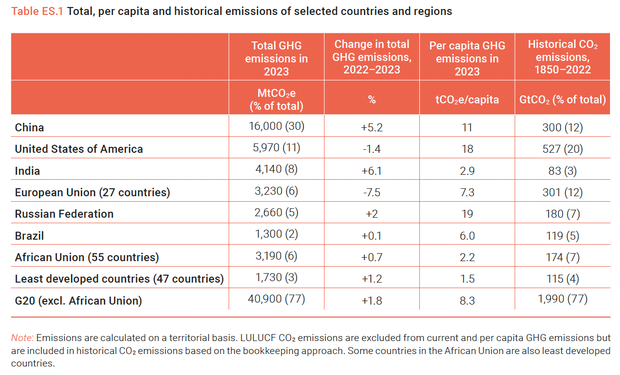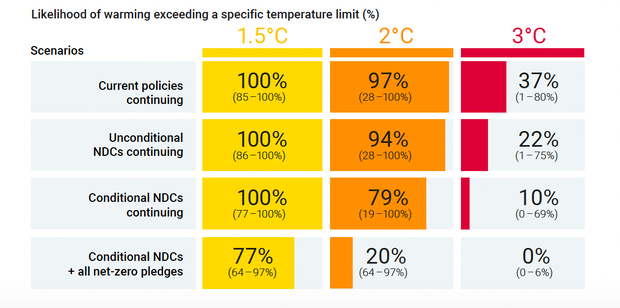Global climate disaster inevitable if emissions aren’t drastically reduced by 2035, U.N. warns
Scientists and experts have been warning for years that if average global temperatures rise by 3 degrees Celsius compared to pre-industrial times, it will be “catastrophic” for people across the world. Now, after a year of record emissions, the United Nations is warning that there are just 10 years to dramatically change policies to prevent the worst impacts of climate change.
In a new report published on Thursday, the U.N. warned that the world is now in “climate crunch time” as greenhouse gases — which trap heat in the atmosphere that warms global temperatures and fuels more extreme weather events — have hit “unprecedented levels.”
Calling it “one of the most urgent climate warnings to date,” the U.N. said that humanity now has just a few years to minimize the worst impacts of climate change.
“The numbers paint a clear picture,” the U.N. said. “To keep emissions below the critical 1.5-degree target set in Paris in 2015, countries must cut emissions by 42 percent overall by 2030 and achieve a 57 percent reduction by 2035.”
For decades, scientists have warned that average global temperatures should not get any higher than 1.5 degrees Celsius compared to pre-industrial times when there was a surge in emissions to prevent deadly weather conditions that will impact people everywhere.
The world has already warmed compared to those times and has seen the effects with back-to-back heat waves, droughts and unprecedented flooding and hurricane events. The way humans are able to grow food has already started to shift, and with 1.5 to 2 degrees Celsius of warming, agricultural yields will decline and sea levels could rise up to 10 feet. Experts say the oceans will also be warmer, fueling more powerful hurricanes and threatening ecosystems that are fundamental for economies and help protect areas from inclement weather.
This scenario is already dangerous, but if that threshold is surpassed, entire island nations will be gone, heat waves will be larger and more frequent and people will be unable to work as much because their bodies will not be able to tolerate the temperature, according to the U.N. report.
“We’re teetering on a planetary tight rope,” U.N. Secretary General Antonio Guterres said. “Either leaders bridge the emissions gap, or we plunge headlong into climate disaster.”
The report, which keeps track of how nations are tackling climate change, found that there needs to be drastic policy changes immediately or else “it will become impossible to reach a pathway that would limit global warming to 1.5°C.”
Global greenhouse gas emissions hit a new record of 57.1 gigatons of CO2 warming equivalent last year, 1.3% higher than levels in 2022. It’s also substantially higher than the average rate seen from 2010 to 2019, when emissions averaged 0.8% of growth per year. The greatest contributors to this rise are the power, industry and transportation sectors.
While U.S. emissions declined by 1.4% from 2022, the nation still ranks No. 2 in the world for its contributions, with China ranking as No.1. Emissions per capita in the U.S., however, surpass China.
United Nations
And when it comes to the emissions gap — the difference between where global greenhouse gas emissions are headed and where scientists say they should be to prevent the worst impacts — the report found a troubling situation. There is currently a 100% chance that global warming will hit 1.5 degrees Celsius unless every nation fulfills pledges for net-zero emissions, but even then, there is still a 77% chance of hitting that threshold.
If global policies continue as is, the likelihood of 2 degrees Celsius of warming is 97%, with a 37% chance of warming hitting 3 degrees Celsius, the report said.
“Today’s Emissions Gap report is clear: We are playing with fire,” Guterres said. “But there can be no more playing for time. We’re out of time.”
But there are solutions available that could reduce these chances. If all Paris Climate Agreement countries drastically limit their emissions to go net-zero as soon as possible, the risk of 2 degrees of warming becomes just 20% and almost completely erases the risk of 3 degrees of warming, the report said. Limiting warming to 1.5 Celsius requires an emissions cut of 7.5% globally every year until 2035.
United Nations
Making that happen, the report says, is up to G20 countries, including the U.S. Increasing the use of solar and wind energy technology could help reduce global emissions by more than a quarter, the report says.
“We would need global mobilization on a scale and pace never seen before,” U.N. Environment Programme executive director Inger Andersen says in the forward of the report. “Many will say this is impossible. But to focus solely on whether it is possible misses one crucial point: the transformation to net-zero economies must happen, and the sooner this global transformation begins the better.”



